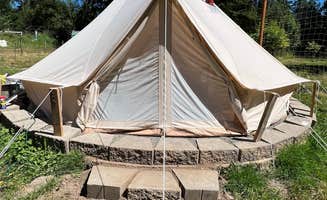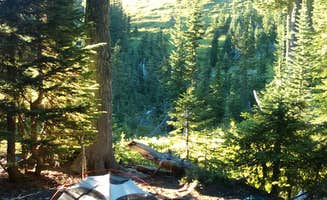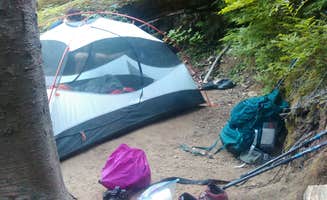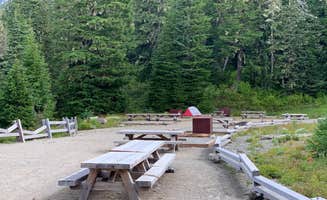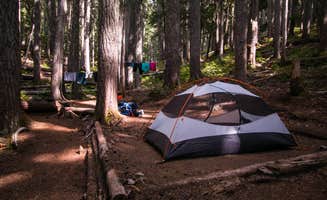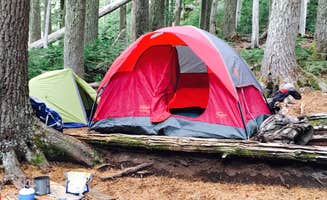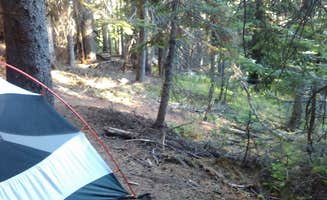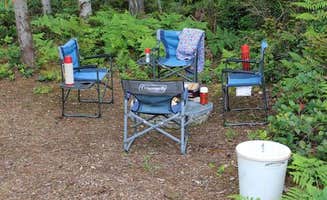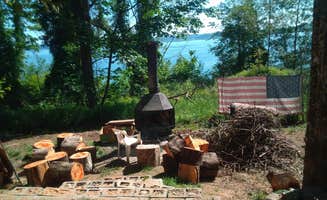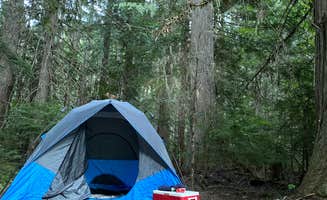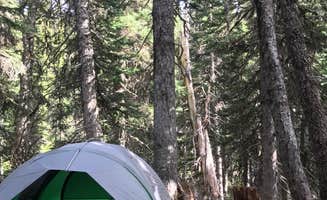Tent campsites near Hobart, Washington often require difficult access during winter months due to seasonal road closures and snow-covered trails. The region sits at the gateway to multiple wilderness areas, with elevations ranging from 800 feet to over 5,000 feet at higher alpine lakes. Campsite availability varies dramatically by season, with most primitive sites becoming accessible only after snow melt in late May through early October.
What to do
Boat-in camping at Blake Island: Access this marine state park campground via personal watercraft or the Argosy ferry from Seattle, about one hour away. "It is a peaceful getaway from the hustle and bustle with gorgeous views of the city. Hike the perimeter trail for views all around the island," notes Christi R. of Blake Island Marine State Park Campground.
Fishing in alpine waters: Many high-elevation tent sites offer fishing opportunities during summer months. "The lake is full of fish so make sure you bring your Pole, beautiful trout were jumping," shares Alex T. about Pratt Lake Hike In Campsite. Water temperatures remain cold even in August.
Snow viewing into summer: Higher elevation tent campsites retain snow well into summer. "Even in July there is snow and temperatures reached as low as 40F," reports kasey about Mowich Lake Campground. Late season hikers can still encounter partially frozen lakes at elevations above 4,000 feet.
What campers like
River sounds for sleep: Many tent campers appreciate waterside sites for natural white noise. "I love the view and the sound of the river! Each site is pretty small...maybe enough for 2-3 tents," shares Jada P. about White River Dispersed Camping. The rushing water also helps mask road noise.
Private forest settings: Several tent-only sites offer secluded camping experiences. "The sites were secluded from one another within a beautiful forest, the toilet was clean and fairly close to the sites," reports Rio B. about Hollyhock Farm. Each of their four tent sites features distinct forest settings.
Seclusion from crowds: Lesser-known tent sites provide quieter alternatives to popular park campgrounds. "I stayed here two nights while visiting MRNP. It was an absolutely beautiful location, about 10-15 minutes away from the Sunrise Entrance. The second night, I managed to find a spot tucked super far in that had a small private beach," writes Corbanzo B. about White River Dispersed Camping.
What you should know
Challenging road access: Many tent camping areas require navigating rough roads. "To get to campground you do have to drive on a dirt road for about 10miles," mentions Adeline T. about Mowich Lake Campground — Mount Rainier National Park. High-clearance vehicles are recommended for several dispersed camping areas.
Variable tent platforms: Some established tent sites feature wooden platforms. "Each spot had a raised platform for your tent, bear box, and picnic table," explains Megan H. about Mowich Lake Campground. These platforms help protect tent floors from ground moisture but require appropriate staking methods.
Bear safety requirements: Several tent camping areas mandate proper food storage. "The camp itself is pretty large, with plenty of tent sites, tables, and bear boxes," notes Marley B. about Ipsut Creek Backcountry Campground. Always check local regulations regarding required food storage containers.
Tips for camping with families
Consider hiking distances: When tent camping with children, evaluate trail difficulty to backcountry sites. "The road into camp is easy, either by foot or bicycle. The road slowly meanders uphill alongside the Carbon River for 5 miles," explains Marley B. about Ipsut Creek Backcountry Campground — Mount Rainier National Park.
Plan for temperature fluctuations: Alpine tent sites experience significant day-to-night temperature changes. "In summer there is generally a burn ban and if you don't have a shaded spot, the heat can be pretty punishing but the temps go way down at night and you'll have a great breeze off of the water," advises Julia S. about Blake Island Marine State Park.
Consider insect protection: Higher elevation tent sites often have significant mosquito populations during summer. "If you can deal with the bugs though this lake is STUNNING. In July there was still ice on the lake, which is at 4500ft," reports Alex T. about Melakwa Lake. Pack appropriate insect repellent and protective clothing.
Tips from RVers
Limited RV accessibility: Most tent campsites near Hobart have poor RV access. "The road can be a bit thin, so I would be careful with extra large vehicles. It is also a bit of a challenging road, so low clearance vehicles wouldn't be treated well," warns P J. about White River Dispersed Camping.
Consider camping near mountain attractions: Tent camping sites provide alternatives when RV campgrounds fill up. "Great place to stay if you can't get a spot at White River / Ohanapecosh," suggests Rich P. about White River Dispersed Camping, noting its proximity to Mount Rainier National Park entrances.
Plan for primitive conditions: Unlike developed RV parks, most tent sites lack amenities. "We ended up overnighting in the day use area as it was dark by this time and not a soul around," reports Geoff T. about Cold Creek Campground, highlighting the need for self-sufficiency when tent camping.


